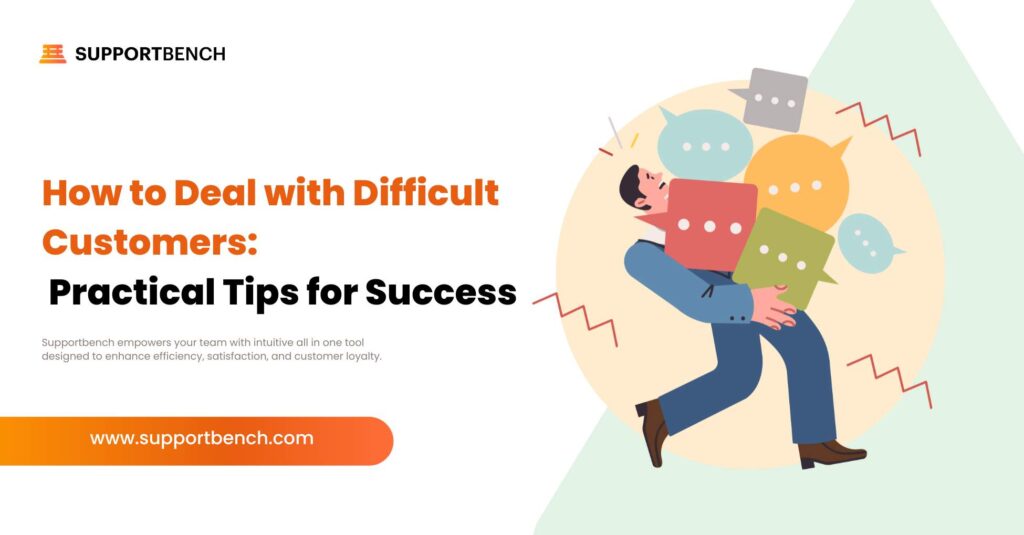Dealing with difficult customers can be a challenging aspect of customer service. However, with the right approach, it’s possible to navigate these issues effectively and maintain positive customer relationships.
In this blog post, we will explore some practical strategies for dealing with difficult customers. By following these tips, you will be better-equipped to de-escalate situations, address customer concerns, and resolve issues professionally and satisfactorily.
Understanding Difficult Customers
Before getting into techniques on how to handle difficult customers, it is essential to understand why specific customers may be more challenging than others. Here are a few common reasons:
- Frustration: The customer may be frustrated with a given product or service, and such frustration may potentially result in aggressive behavior.
- Misunderstandings: There may be misunderstandings about your products and services or your policies, leading to confusion and frustration.
- Unrealistic expectations: The underlying cause may also be unrealistic expectations about your products or services, and when such expectations are not met, the customer may become hard to handle.
- Personal problems: Sometimes, problems make customers more difficult to deal with.
Knowing the true causes of difficult customer behavior allows you to tailor your approach better to handle the situation and fix their problems effectively.
Types of Difficult Customers

The Angry or Rude Customer
These customers tend to be impatient, disrespectful, and explosive. Whenever things don’t go according to their expectations, they may shout at you, use abusive language, or attack your personality.
How do you handle rude and unhappy customers?
- Stay calm: Do not get angry when spoken to aggressively; do not take such anger personally.
- Acknowledge their feelings: Lend a sympathetic ear and show empathy.
- Focus on conflict resolution: Change the direction of their conversation toward finding a solution.
- Set boundaries: If abuse persists, excuse yourself politely yet firmly.
The Demanding Customer
These customers have unrealistically high expectations and make demands beyond company policy.
How to handle them:
- Be polite yet firm: Clearly and professionally explain company policies.
- Offer options: Provide alternatives within company policy that meet their needs.
- Escalate: If the issue can’t be resolved, explain that you’ll refer it to a supervisor or manager.
The Indecisive Customer
Indecisive customers have difficulty making decisions or stating clear preference.
How to handle them:
- Be patient: Do not try to push them, and do not look irritated.
- Probe for details: Ask them questions that will narrow their choices down.
- Provide product knowledge: Mention what each product/service can offer them, depending on their needs.
- Reiterate options: Repeat back to them what it is that they seem to be leaning toward to lock in an answer.
- Confirm Decision: When leaning toward one, confirm it with them for subsequent action.
The Complainer
It is observed that some customers generally complain, even if their issue has already been resolved.
How to cope with them:
- Put it on paper: Clearly document the points discussed in each call.
- Follow procedures: Process their complaint based on the procedures and policy stated by your company.
- Be professional: Be empathetic and solution-oriented, and do not get into arguments.
- Set boundaries: If they call several times with unjustified complaints, it is okay to say that you have already taken care of what they asked for and that you cannot compensate them anymore.
The Price-Sensitive Customer
These are the type of customers who are most concerned with getting the best possible price.
How to handle them:
- Know your leeway: Know how much discount you can give.
- Add value: Explain the product features and the benefits it will provide to justify the price.
- Alternative Products: Suggest similar products with lower price points, if possible.
- Insist on your price: Say no to unreasonable requests. Politely explain to the customer that this is the most reasonable price you can offer.
The Unresponsive Customer
Unresponsive customers are those who do not give the necessary information or refuse to answer questions.
How to handle them:
- Multi-channel communication: Reach out through different methods (e.g., phone, email, chat) to increase the chances of getting a response.
- Establish deadlines: Communicate deadlines or consequences for their lack of communication.
- Offer options: Provide options of preferred channels to communicate on.

More Communication Techniques to Help You Deal with Difficult Customers
Besides the previous strategies, here are more techniques that will help you effectively handle difficult customers:
- Do not be defensive or personal about the situation; always keep calm and composed.
- Listen actively to what the customer has to say and try to understand them.
- Acknowledge feelings by showing empathy and understanding for the frustrations of the customer.
- Do not argue since your goal should be to find a solution rather than an argument with the customer.
- Set clear expectations. Be transparent as to what you can and cannot do to help. Escalate if necessary. Should the situation continue to worsen or you feel unsafe, don’t hesitate to escalate the issue to a supervisor.
- After the interaction, follow up with the customer to ensure they are satisfied with the resolution.
By following these tips, you will go a long way toward improving your skills at handling difficult customers and maintaining positive customer relationships.
Knowing When to Involve a Manager
There are some situations where you need to refer a customer to your manager. Here are some scenarios that you should look out for:
- Threats/verbal abuse: If the customer threatens you or becomes verbally abusive, take the call to your supervisor.
- Safety: If you feel that the customer is going to create a safety risk either to you or somebody else, then this immediately needs to be escalated.
- Policy exceptions: Whenever a customer requests something that is against a policy, for which it is beyond your authority to waive or change, always refer to your manager for advice or alternatives.
- Deadlocks: If you reach a stalemate, whereby you are unable to find a resolution, you should refer the matter to your manager for a fresh look or extra authority to resolve the complaint.
- Uncomfortable situations: It is important to step away from a conversation if a customer’s remarks make you uncomfortable or if they express discriminatory views. Always refer to your manager on the best course of action.

Supportbench: Your Partner in Exceptional Customer Service
Supportbench empowers your business to be more operational, customer-friendly and growth-oriented with an all-inclusive customer support platform. Drawing on our powerful features, you can:
- Manage tickets effectively: Keep a close watch and resolve customer inquiries with ease.
- Automate workflows: Make repetitive tasks more straightforward and convenient.
- Provide a knowledge base: Allow the customer to self-serve answers for themselves.
- Analyze performance: Gather valuable insights into customer behavior and understand areas for improvement.
Ready to transform your customer support?
Schedule a free demo today and see how Supportbench powers businesses like yours in delivering exceptional customer service for achieving your goals.
FAQs
1. How can I tell if a customer might be difficult before things get tough?
While there is no magic formula that dictates this, there are some cues that may very well indicate an incoming problem. These include:
- Tone of voice escalation
- The use of aggressive or insulting speech.
- Past complaints history
- Unrealistic expectations
2. What should I do when a customer becomes abusive?
The most important rule is your safety. If a customer is becoming verbally abusive, de-escalate the situation by excusing yourself from the conversation, getting a supervisor involved, or ending the interaction.
3. How do I avoid the escalation of difficult customer interactions?
Following are a few tips that will help in avoiding the escalation of problematic customer interactions:
- Pay attention to what the customer is saying, and try to understand their point of view.
- Acknowledge their feelings. Let them know that you can imagine how frustrated they must feel.
- Avoid arguments. Instead of arguing with the customer, focus on solution-finding.
- Set clear expectations. Be transparent with the customer about what you can and cannot do to resolve the issue.












